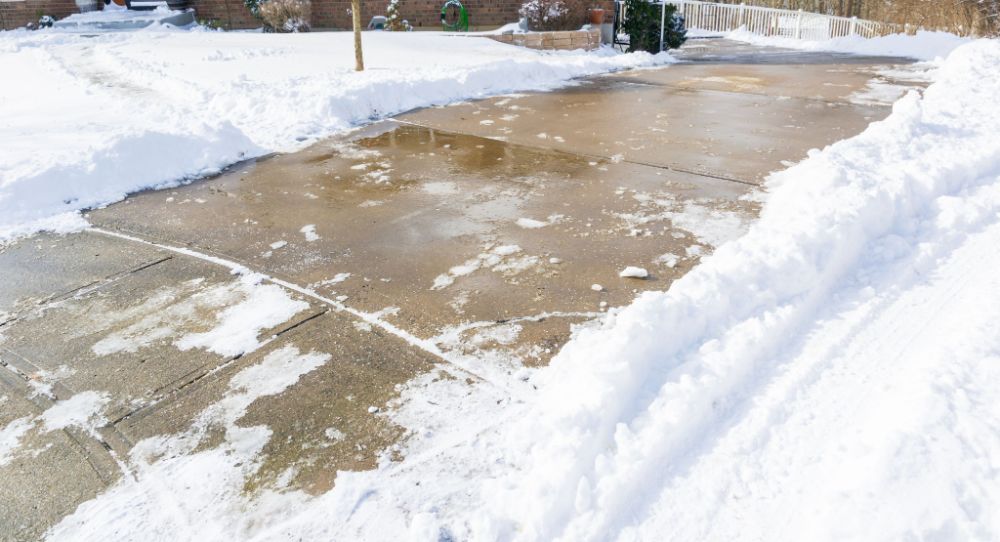Ice is a big problem in winter as it covers the roads, paths and driveways causing people and vehicles to slip.
When there is ice on your driveway, you need to melt it as fast as possible to ensure you and your family's safety.
Most people use salt to melt the ice, but for concrete driveways this usually isn't advised and there are a bunch of alternative options out there. Some are more pet or eco friendly, some use items you can find in your home cupboard while others work even better than regular salt.
There are several ways you can melt ice on your driveway in winter without salt. Some of these methods include using hot water, sugar, heated mats, Calcium Chloride, vinegar, Alfalfa meal, and other fertilizers, Magnesium Chloride, sugar beet juice with pickle brine, and so much more!
How do these salt alternatives work and how do you use these methods to melt the ice on your driveway?
We will discover the answers to these salt alternative questions so you can find the perfect de-icing method for you!
Best Ways To Remove Ice From A Driveway Without Salt
Winter is a lovely time of year and many people enjoy the snow it can bring. However, this snow can cause some unwanted side effects that can be dangerous, including the formation of ice on driveways and sidewalks.
Ice on your driveway can lead to painful falls for you and your family, so you need to melt it as soon as possible to remove the slipping hazard and so you have regular traction for cars and people.
Most people use salt to melt ice, but salt can damage your driveway and your plants due to runoff, and it can harm your pets and rust your car.
People also use ice melt to help with ice. Other forms of ice melt can work better than salt of be more eco-friendly. However it can also clump together, and you will need to de-clump the ice melt before you can use it. Not everyone has time for this, though.
Salt can also sell out quickly at the stores when snow unexpectedly blows in and there is a run on the product.
So, if you don't have salt to melt the ice or don't want to use salt, what other options do you have? Let's look at some salt alternatives for melting the ice in your driveway.
1. Hot Water
If it's not extremely cold of the simplest ways to melt the ice in your driveway is using hot water. You can heat the water you need in a pot on your stove or your kettle and take it outside to your driveway.
You'll only want to do this when outside temperatures are above freezing as otherwise the water will eventually freeze giving you an even bigger ice problem.
Gently pour the hot water onto the ice, ensuring that the hot water doesn't splash onto you. Then place the pot or kettle back inside and quickly go and shovel the ice off your driveway.
The hot water should melt the ice enough for you to shovel it away without difficulty.
2. Homemade Solution
You can try this method of making a homemade ice melting solution with the items you probably already have in your home.
For this homemade solution, you will need 1 tablespoon of dish soap, 3-4 tablespoons of rubbing alcohol, and one pot or kettle full of hot water. Mix the dish soap and the rubbing alcohol in a bowl and carefully add the hot water to the mixture.
Gently stir the mixture and carefully pour it onto the ice on your driveway. This will melt the ice and make it easier for you to remove the remaining ice chunks.
The dish soap and rubbing alcohol lower the freezing point of ice just like salt does, causing the ice to melt faster than it otherwise would
3. Sugar
If you are trying to avoid using salt to melt the ice on your driveway, as you don't want the salt to damage your driveway or plants, then you can use sugar as an alternative ice melting option.
Sugar is not as effective as salt, but it still works relatively well. The granules will also add some traction to the path or driveway while the melting process begins
All you need to do is take your bag of normal sugar and pour it over the ice like you would with the salt. Leave the sugar on the ice, and the sugar will melt fairly well. This usually only works in temperatures down to about 28ºF (-2ºC).
The nice thing about using sugar is that it will all dissolve in the ice, meaning there is nothing to clean up afterward like there usually is with salt.
4. Break It Up With A Shovel
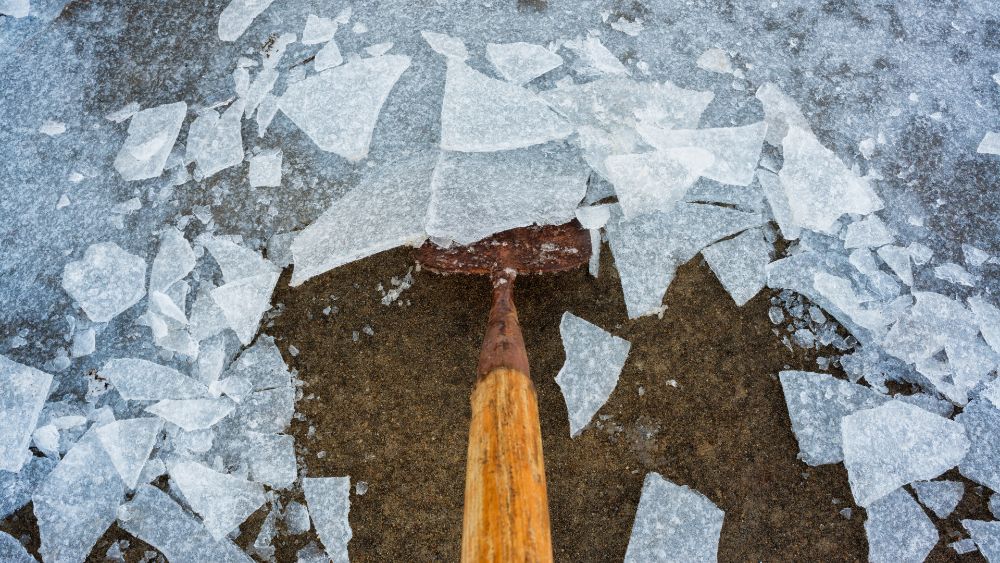
If you have the energy and strength for it, you can also try to break the ice up on your driveway using a shovel. This will take a long time and a lot of energy and is only recommended for thin layers of ice, not ice and snow that has been packed down tightly.
Still it costs you nothing, is very eco-friendly and while it's a lot of work it's also very effective.
You will need to use a sturdy metal shovel to ensure the shovel has enough strength to break up the ice.
Metal shovels also have a sharper edge which will help you cut through the ice easier. Just be sure to wear some warm gloves for this method.
5. Sugar Beet Juice & Pickle Brine
Another great method you can use to help melt the ice in your driveway is sugar beet juice and pickle brine.
Sugar beet juice has a very low freezing point, and the pickle brine is slightly salty, so mixing these two together will help melt the ice on your driveway even when the temperature is around 10°F (-12ºC).
Below you can see a video showing more details about how effective this is.
This is an excellent method as the sugar beet juice and the pickle brine will not harm your driveway or plants as much as salt will and will melt the ice.
Depending on the mixture sometimes it doesn't work as well as ice so can't really be used in super cold temperatures.
6. Heated Mats
Heating mats are another great alternative to salt for melting the ice on your driveway. These are great for paths or porches but are a bit expensive if you plan on covering your entire driveway.
If you have time you can move them around as they melt the ice on the driveway.
Focus on melting the ice where the car tires come in contact with the driveway as well as making a safe path to walk to the car. You can leave the rest frozen if you wish.
Or you can buy a few of them and keep them on your walkways and stairs or make a walkway with them on your driveway to create a safe path for you and your family to walk on.
Even though these mats are expensive and require electricity, they are extremely effective at melting ice and they don't leave any residue. You won't be disappointed with them.
See the latest price of heated mats at Amazon
7. Magnesium Chloride
Magnesium Chloride is a great alternative to salt for melting ice, and it's safe for pets and plants and won't damage your driveway like salt can.
Magnesium Chloride is more expensive than salt, but it works extremely well and can melt ice when the temperature is 5°F (-15ºC).
This makes Magnesium Chloride even better than salt when it comes to melting ice. You can also use this option on your garden paths to ensure you are safe wherever you choose to walk.
See the latest price of Magnesium Chloride at Amazon
8. Calcium Chloride
Calcium Chloride is more efficient than rock salt when melting ice and can melt the ice faster. In fact it's one of THE MOST EFFECTIVE ice melt options out there.
Calcium Chloride works in much colder temperatures than rock slat can; it can melt ice at temperatures as low as -25°F (-31ºC). This stops the melting and refreezing that can happen with rock salt at night when temperatures drop.
This means Calcium Chloride is usually one of the best options for concrete driveways.
As this product is more effective than rock salt, you won't need as much of it to get the job done, which makes up for the relatively expensive price tag of Calcium Chloride. You can spread out just a tiny little bit and you'll be shocked at how effective it works. It also lasts years.
For best results you can apply calcium chloride ice melt the night before so that ice never forms on your driveway in the first place.
See the latest price of calcium chloride at Amazon
9. Alfalfa Meal
If you want to go all-natural and eco-friendly when melting the ice on your driveway, then Alfalfa meal is the perfect option. This is a type of fertilizer that is eco-friendly and animal friendly. This fertilizer has a good amount of nitrogen, an ice-melting agent.
The Alfalfa meal also has a gritty texture that can help add grip to your driveway while the ice is melting. You will need to leave the fertilizer on the ice overnight and clean it up when it has melted.
See the latest price of Alfalfa Meal at Amazon
10. Urea
Urea is not what you might think it is, so don't start keeping a bucket in your bathroom just yet. Urea is a type of fertilizer that contains ammonia and carbon dioxide.
This fertilizer has a higher concentration of nitrogen in it than the Alfalfa meal, meaning it will melt the ice faster.
However, you should not use this option if you live close to a water supply like a lake or pond. Urea can contaminate the water in these areas and affect the animals and wildlife that rely on the water source for survival.
See the latest price of Urea at Amazon
11. Potassium Acetate
Potassium Acetate is not the best option for most people as it is difficult to find and expensive, but if you can purchase some, it's one of the best salt alternatives to melt ice.
Potassium Acetate has a freezing point of -75°F (-60ºC), meaning you can use this product to melt ice in any weather you find yourself in.
Potassium Acetate is also biodegradable and non-corrosive, but you can't use it near water sources as it will affect the oxygen levels in the water, killing wildlife.
See the latest price of Potassium Acetate at Amazon
12. Reflectors To Direct Sunlight
Another thing you can purchase to help melt the ice on your driveway is sunlight reflectors. You can set these up and point the reflectors towards the ice that needs to be melted. The sun's rays will then be directed to the ice, which will melt ice.
These will only work on sunny days, and it will take a while to melt the ice completely, but you are easy to use and work relatively well.
13. Black Plastic Mats To Absorb Heat From The Sun
You can also use black plastic mats to help melt the ice on your driveway. Black mats will absorb heat from the sun and will begin to melt the ice on your driveway.
This is an easy method, but it can be expensive depending on how big your driveway is and how many mats you need.
You can get rubber mats but these will insulate against the sun's heat and take longer to warm up themselves as well as the ice on your driveway. I have found that black weed barrier mats are more affordable for covering a larger surface and they melt ice faster.
They also provide traction when placed over ice to stop slipping and can be stored and used for years.
See the latest price of black weed barrier mats at Amazon
14. Vinegar
A household item you might have lying around that can help you melt the ice on your driveway is vinegar.
Vinegar works well to melt ice but will not work if the temperature is below 28°F (-2ºC). This product is natural and safe for animals and people but can damage car paint and plants due to its acidity.
Mix water with vinegar at a ratio of 50:50 and pour this mixture over the ice. The ice should melt quite quickly.
15. Use A Snow Blower
Using a snow blower to melt the ice on your driveway is a great alternative to salt. You will need electricity access for this option as the snow blower requires power to create hot air to blow on the ice.
Snow blowers are generally good, but if there is a lot of ice, it might not melt. You need to make numerous passes with the snow blower to ensure all the ice has melted.
16. Radiant Heating
A radiant heating system is an excellent way to melt ice on your driveway. However, this system needs to be installed into the concrete of your driveway, and it can be expensive to install, maintain and run.
This system of pipes under the driveway pumps warm or hot liquid through all the pipes, which helps melt the ice on the ground. If you can afford this ice melting system, then it's worth the money.
17. Fertilizer
If you don't have Alfalfa meal or Urea close at hand but have other fertilizers, then you are still in luck. You can use most fertilizers to help melt the ice on your driveway as long as the fertilizer has nitrogen.
It can take a while for the fertilizer to melt the ice, but it will also add some grip making it less likely that you will fall even while the ice is still present.
18. Deice Sparingly, Then Shovel
If you need to use a de-icer like ice melt to help get rid of the ice on your driveway, you can use this method to ensure your driveway, plants, and the nearby wildlife are kept safe.
You can use the de-icer sparingly and then shovel away the rest when the ice starts to break up.
This way, you use as little of the de-icer as possible to get the job done. This method will require extra effort from you as you will need to shovel the ice off your driveway as it starts breaking up.
Bonus – Won't Melt Ice But Provides Grip
These bonus items are great for adding to the ice on your driveway to add some extra grip so that you won't fall. However, these will not melt the ice.
19. Sand
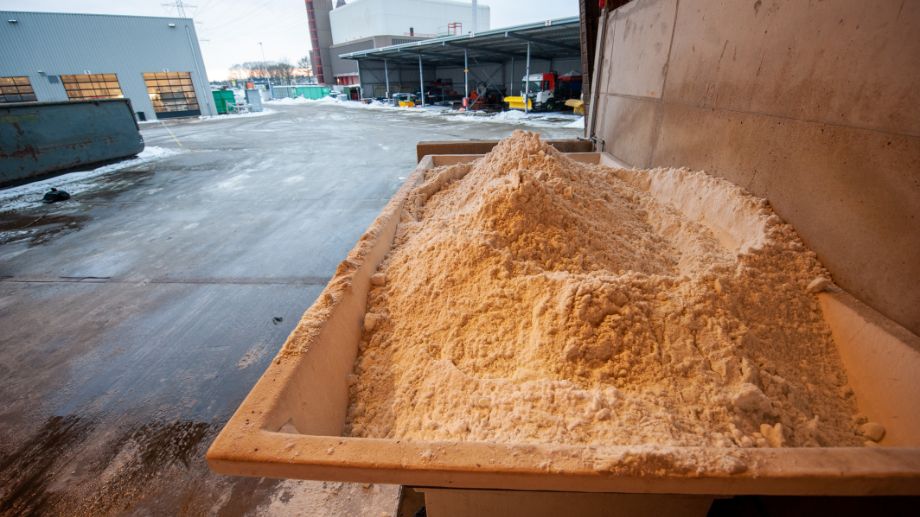
You can place sand on your driveway that is iced up to help add some extra grip to the area. You can use any type of sand for this purpose, including the sand from your garden, so it's a cheap option.
Sand doesn't melt ice – it only provides traction on top of the ice. But it's eco-friendly and can be easily swept into the garden after the weather warms up and the ice has melted.
20. Kitty Litter
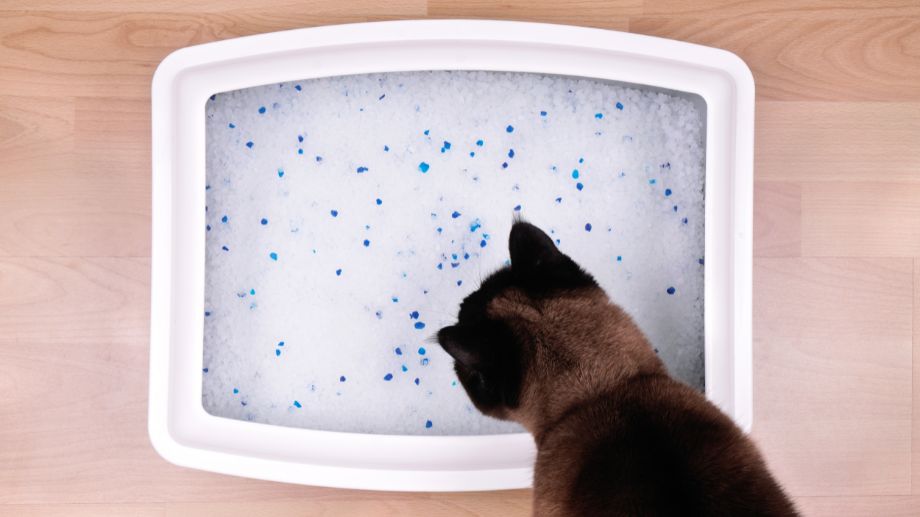
When stores have run out of sand then kitty litter is another great option to place on the ice on your driveway to add some grip to the area.
You can use this method if the ice is thick and extra slippery. Remember, kitty litter doesn't melt ice it just provides traction like sand does.
This is more expensive than sand, as kitty litter can be costly, and you will also need to clean it up once the ice has melted. Just make sure you buy the right kitty litter for ice as some types are better than others.
21. Coffee Grounds
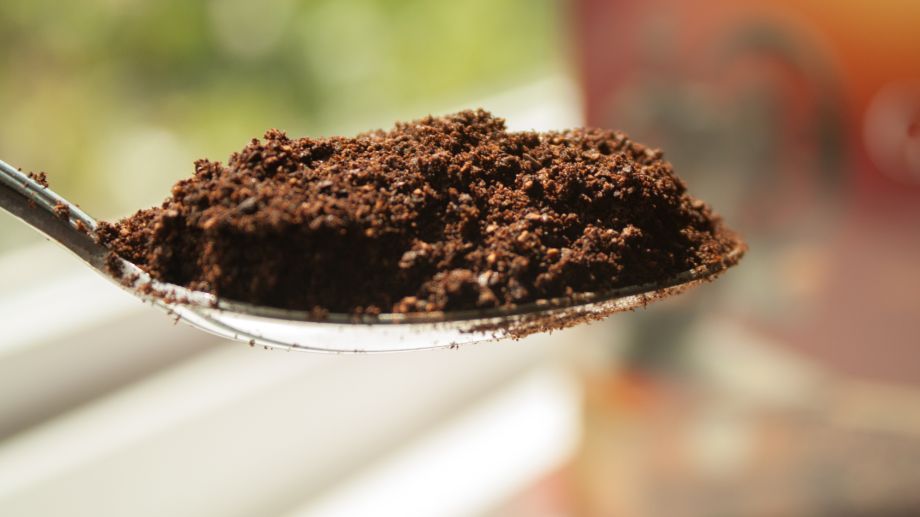
If you drink a lot of coffee (like I do) and don't know what to do with the leftover coffee grounds, keep them for the ice on your driveway.
This is a great method of recycling the coffee grounds while making the ice on your driveway less slippery.
Plus, you won't need to clean it up once the ice melts as coffee grounds are good fertilizer for plants.
22. Ash
If you are lucky enough to have a fireplace in your home, you can use the ash that accumulates to help add some grip to your icy driveway.
Spreading the ash over the ice will help make the ice less slippery. You won't need to clean the ash when the ice melts as it will dissolve in the water.
Conclusion
Having ice on your driveway is an annoying and dangerous problem that you need to fix as soon as possible before someone falls and gets hurt.
Many people don't want to use salt for the ice as the salt can damage the driveway and surrounding plants.
Thankfully, there are many salt alternatives available that do an excellent job at melting the ice on driveways. You can pick one or two methods from the list above, and your driveway will return to its non-slippery self in no time!

